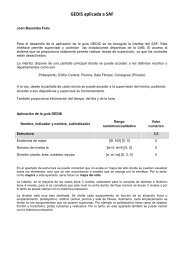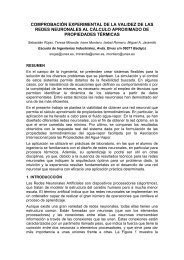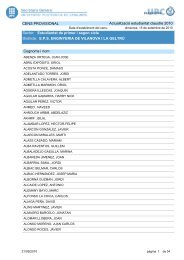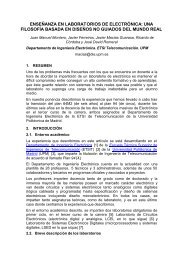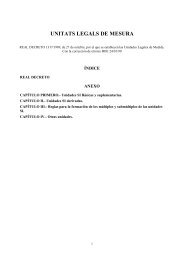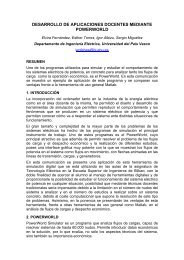Interface Design Improvement in Supervisory Control
Interface Design Improvement in Supervisory Control
Interface Design Improvement in Supervisory Control
You also want an ePaper? Increase the reach of your titles
YUMPU automatically turns print PDFs into web optimized ePapers that Google loves.
<strong>Interface</strong> <strong>Design</strong> <strong>Improvement</strong> <strong>in</strong> <strong>Supervisory</strong><br />
<strong>Control</strong><br />
Pere Ponsa 1 , Ramon Vilanova 2 , Marta Diaz 3 , Anton Gomà 4<br />
1 Automatic <strong>Control</strong> Department, Technical University of Catalonia<br />
Av. Victor Balaguer s/n, 08800 Vilanova i la Geltrú, Spa<strong>in</strong><br />
Pedro.Ponsa AT upc.edu<br />
2 Telecomunication and Systems Eng<strong>in</strong>eer<strong>in</strong>g Department, Universitat<br />
Autónoma de Barcelona<br />
ETSE, 08913 Bellaterra, Spa<strong>in</strong><br />
Ramon.Vilanova AT uab.cat<br />
3 4all-L@b Usability Laboratory, Technical University of Catalonia,<br />
Av. Victor Balaguer s/n, 08800, Vilanova i la Geltrú, Spa<strong>in</strong><br />
Marta.Diaz AT upc.edu<br />
4 S.A.F. Sports Service Area, Universitat Autónoma de Barcelona<br />
08913 Bellaterra, Spa<strong>in</strong><br />
Anton.Goma AT uab.cat<br />
Abstract In tasks of human supervision <strong>in</strong> <strong>in</strong>dustrial control<br />
room several generic discipl<strong>in</strong>es such as the software eng<strong>in</strong>eer<strong>in</strong>g<br />
for the design of the comput<strong>in</strong>g <strong>in</strong>terface and the human factors<br />
for the design of the control room layout come <strong>in</strong>to application.<br />
From the po<strong>in</strong>t of view of the human computer <strong>in</strong>teraction, to<br />
these discipl<strong>in</strong>es it is necessary to add the usability eng<strong>in</strong>eer<strong>in</strong>g<br />
and the cognitive ergonomics s<strong>in</strong>ce they contribute rules for the<br />
user centered design. The ma<strong>in</strong> goal of this work is the application<br />
of a guidel<strong>in</strong>e for supervisory control <strong>in</strong>terface design <strong>in</strong><br />
order to improve the efficiency of the human mach<strong>in</strong>e systems <strong>in</strong><br />
automation. This communication presents the work developed<br />
to improve the Sports Service Area <strong>in</strong>terface of the Universitat<br />
Autónoma de Barcelona.<br />
1 Introduction<br />
In recent years, control systems and the role of control room human operators<br />
have changed dramatically [13]. Human operator activity has evolved<br />
from manually perform<strong>in</strong>g the process, to control system supervision. Today,<br />
the human operator requires an <strong>in</strong>-depth knowledge of the process<br />
that he/she is oversee<strong>in</strong>g and the ability to make effective decisions with<strong>in</strong><br />
demand<strong>in</strong>g constra<strong>in</strong>ts.<br />
The <strong>in</strong>creased complexity of <strong>in</strong>dustrial process control systems calls<br />
for a new methodological approach (for research and design purposes),<br />
Pere Ponsa, Ramon Vilanova, Marta Diaz, Anton Gomà “<strong>Interface</strong> <strong>Design</strong><br />
<strong>Improvement</strong> <strong>in</strong> <strong>Supervisory</strong> <strong>Control</strong>” Vol. I No. 3 (Dec. 2007). ISSN: 1697-9613<br />
(pr<strong>in</strong>t) - 1887-3022 (onl<strong>in</strong>e). www.em<strong>in</strong>ds.uniovi.es
Pere Ponsa, Ramon Vilanova, Marta Diaz, Anton Gomà<br />
which reproduces the essential components of current control systems:<br />
the environment, the task at hand and human operator activity [19].<br />
The complexity of <strong>in</strong>dustrial process supervision makes it necessary<br />
to supplement the Human Factors approach and the Human-Computer<br />
Interaction approach with a cross-discipl<strong>in</strong>ary cooperation <strong>in</strong> order to <strong>in</strong>tegrate<br />
knowledge and methods from other fields, especially Cognitive<br />
Ergonomics, Automation and Artificial Intelligence [1] [2] [6], [7] [9]. Our<br />
view is that complete control systems eng<strong>in</strong>eer<strong>in</strong>g must encompass all<br />
these approaches.<br />
Ergonomics is concerned with the adaptation of technology to suit<br />
human operator needs and ability so as to achieve effectiveness, efficiency<br />
and user/worker satisfaction and comfort [3].<br />
<strong>Supervisory</strong> control is conceived as the set of activities and techniques<br />
developed over a set of controllers (programmable logic controllers and<br />
<strong>in</strong>dustrial regulators) which ensures the fulfill<strong>in</strong>g of control goals. One of<br />
the ma<strong>in</strong> goals is to prevent possible plant malfunctions that can lead to<br />
economical lose and/or result <strong>in</strong> damage [16]. For this reason, other fields<br />
of knowledge concerned with manufactur<strong>in</strong>g systems performance - such<br />
as ma<strong>in</strong>tenance and <strong>in</strong>dustrial security - are complementary <strong>in</strong> the study<br />
and application of supervision systems.<br />
In this paper a methodology for the creation of a human factor guidel<strong>in</strong>e<br />
for supervisory control <strong>in</strong>terface design is proposed. In section 2 a<br />
checklist of <strong>in</strong>dicators of the guidel<strong>in</strong>e called ’ergonomic guidel<strong>in</strong>e for supervisory<br />
control <strong>in</strong>terface design’ (GEDIS) is presented. The framework<br />
for the application of the presented guidel<strong>in</strong>e is the Sports Service Area<br />
project is described <strong>in</strong> section 3. The purpose is not to cover with detail<br />
the entire project but to give an idea of the different k<strong>in</strong>d of topics that<br />
have been covered. In section 4, transition from the GEDIS model to<br />
Sports Service Area <strong>in</strong>terface <strong>in</strong> control room is evaluated. In this section<br />
a usability framework to improve control room design and a set of<br />
recommendations about graphical <strong>in</strong>terface improvement are presented.<br />
F<strong>in</strong>ally, conclusions and future research l<strong>in</strong>es are outl<strong>in</strong>ed.<br />
2 GEDIS Guidel<strong>in</strong>e<br />
The previous research on human <strong>in</strong>terface design guidel<strong>in</strong>es <strong>in</strong>cludes, for<br />
example, the standard ISO 11064 that establishes ergonomic pr<strong>in</strong>ciples for<br />
the evaluation of control centers [8], the Human Factors <strong>Design</strong> Standards<br />
(HFDS) of the Federal Aviation Adm<strong>in</strong>istration of the United States [5] ,<br />
the Human <strong>Interface</strong> <strong>Design</strong> Review Guidel<strong>in</strong>es NUREG 0700 <strong>in</strong> nuclear<br />
power plants [21], the I-002 Safety and Automation Systems NORSOK<br />
about Norwegian petroleum <strong>in</strong>dustry [15] and the Man Systems Integration<br />
Standard NASA-STD-3000 about manned space programs [11]. Table<br />
(1) provides a comprehensive summary of the different approaches and<br />
correspond<strong>in</strong>g application doma<strong>in</strong>s:<br />
22
<strong>Interface</strong> <strong>Design</strong> <strong>Improvement</strong> <strong>in</strong> <strong>Supervisory</strong> <strong>Control</strong><br />
Table 1: User <strong>Interface</strong> <strong>Design</strong> Guidel<strong>in</strong>es<br />
Standard - Description<br />
Doma<strong>in</strong><br />
Guide<br />
HDFS Human factors practices and pr<strong>in</strong>ciples<br />
Aviation<br />
<strong>in</strong>tegral to the procurement,<br />
design, development, and test<strong>in</strong>g<br />
of Federal Aviation Adm<strong>in</strong>istration<br />
(FAA) systems, facilities, and equipment<br />
of the United States<br />
NUREG700 Human factors eng<strong>in</strong>eer<strong>in</strong>g (HFE)<br />
aspects of nuclear power plants <strong>in</strong><br />
accordance with the Standard Review<br />
Plan of the U.S.<br />
NORSOK-<br />
SAS<br />
MSIS<br />
This standard of the Norweg<strong>in</strong>a<br />
petroleum <strong>in</strong>dustry covers functional<br />
and technical requirements<br />
and establishes a basis for eng<strong>in</strong>eer<strong>in</strong>g<br />
related to Safety and Automation<br />
System <strong>Design</strong>.<br />
This document provides specific<br />
user <strong>in</strong>formation to ensure proper<br />
<strong>in</strong>tegration of the man-system <strong>in</strong>terface<br />
requirements with those of<br />
other aerospace discipl<strong>in</strong>es<br />
Nuclear<br />
Power Plant<br />
Petroleum<br />
<strong>in</strong>dustry<br />
Aerospace<br />
GEDIS is not a Standard, is a guidel<strong>in</strong>e and can be used <strong>in</strong> oil and<br />
gas <strong>in</strong>dustry, for example. It is necessary to stablish a Standard <strong>in</strong> the<br />
<strong>in</strong>dustrial doma<strong>in</strong>. The GEDIS guidel<strong>in</strong>e is a first approach.<br />
In order to <strong>in</strong>troduce the GEDIS guide it is necessary to def<strong>in</strong>e the<br />
relationship between the designer, the human supervisor and the control<br />
room operator. There are a variety of expert-review methods [20]:<br />
- Heuristic evaluation (the eight golden rules of <strong>in</strong>terface design<br />
- Guidel<strong>in</strong>es review (organiz<strong>in</strong>g the display, gett<strong>in</strong>g the user’s attention)<br />
- Consistency <strong>in</strong>spection (the experts verify consistency of term<strong>in</strong>ology,<br />
color, layout, etc.)<br />
- Cognitive walkthrough (the experts simulate users walk<strong>in</strong>g through<br />
the <strong>in</strong>terface to carry out typical tasks)<br />
- Formal usability <strong>in</strong>spection<br />
An example of cognitive modell<strong>in</strong>g <strong>in</strong> human computer <strong>in</strong>teraction<br />
is the GOMS guidel<strong>in</strong>e, about goals, operators, methods and selection<br />
23
Pere Ponsa, Ramon Vilanova, Marta Diaz, Anton Gomà<br />
rules <strong>in</strong> usability analysis [4]. In comb<strong>in</strong>ation with Keystroke-Level Model<br />
(KLM) an <strong>in</strong>terface can be studied, also task execution time and human<br />
efficiency can be studied too.<br />
Table 2: Characterization of Human Computer Interaction guidel<strong>in</strong>es<br />
Method-<br />
Characteristic<br />
GEDIS GOMS Heuristic<br />
Evaluation<br />
Reach Total and partial Total but<br />
detailed<br />
not detailed<br />
Include Human <strong>Supervisory</strong><br />
Yes No No<br />
<strong>Control</strong><br />
Elements?<br />
Include Software No Yes No<br />
Toolbox?<br />
Include Numeric Yes No No<br />
Evaluation?<br />
Evaluation Guide M<strong>in</strong>imum Complex Extensive<br />
The GEDIS guide is a method that seeks to cover all the aspects<br />
of the <strong>in</strong>terface design [18]. From the <strong>in</strong>itial po<strong>in</strong>t of view of strategies<br />
for effective human-computer <strong>in</strong>teraction applied to supervision tasks <strong>in</strong><br />
<strong>in</strong>dustrial control room [14], [20].<br />
The GEDIS guide can provide design recommendations at <strong>in</strong>terface<br />
creation time as well as recommendations for improvement of already created<br />
<strong>in</strong>terfaces. The GEDIS guide is composed of two parts: description<br />
of ten <strong>in</strong>dicators and measure of ten <strong>in</strong>dicators. The <strong>in</strong>dicators have been<br />
def<strong>in</strong>ed from extracted concepts of other generic human factors guidel<strong>in</strong>es,<br />
and for aspects of human <strong>in</strong>terface design <strong>in</strong> human computer <strong>in</strong>teraction.<br />
The method for the application of the GEDIS guide is: analyze the<br />
<strong>in</strong>dicator, measure the <strong>in</strong>dicator, obta<strong>in</strong> the global evaluation <strong>in</strong>dex and<br />
f<strong>in</strong>ally offer recommendations of improvement.<br />
For the correct use of the GEDIS guide it is necessary the collaboration<br />
between the control room technical team and the human factor<br />
technician, s<strong>in</strong>ce <strong>in</strong> some cases to analyze the <strong>in</strong>dicator is necessary the<br />
expert’s op<strong>in</strong>ion.<br />
2.1 Indicators List<br />
The GEDIS guide consists of ten <strong>in</strong>dicators that seek to cover all the<br />
aspects of the <strong>in</strong>terface design <strong>in</strong> the supervisory control doma<strong>in</strong>. The <strong>in</strong>dicators<br />
are: architecture, distribution, navigation, color, text font, status<br />
of the devices, process values, graphs and tables, data-entry commands<br />
and, f<strong>in</strong>ally, alarms. For example, the relationship between architecture<br />
and navigation <strong>in</strong>dicators is illustrated <strong>in</strong> Fig. 1. The physical plant can<br />
be structured <strong>in</strong> area, subarea, and team. In the same way, the <strong>in</strong>terface<br />
24
<strong>Interface</strong> <strong>Design</strong> <strong>Improvement</strong> <strong>in</strong> <strong>Supervisory</strong> <strong>Control</strong><br />
presents four navigation levels. Fig. 1 shows a possible layout to locate all<br />
the connections between screens. The connection among screens is complex<br />
<strong>in</strong> a supervisory control <strong>in</strong>terface. From the po<strong>in</strong>t of view of human<br />
computer <strong>in</strong>teraction, is a typical example of cyclic network menu.<br />
Figure 1: A typical cyclic network menu <strong>in</strong> supervisory control <strong>in</strong>terface<br />
associated to navigation <strong>in</strong>dicator (the user can jump around the branches<br />
of the tree, go back to the previous menu, or to go to the beg<strong>in</strong>n<strong>in</strong>g)<br />
Figure 2: An example of object’s layout <strong>in</strong>side the screen for the distribution<br />
<strong>in</strong>dicator. The display must be simple because the limitation of<br />
human <strong>in</strong>formation process<strong>in</strong>g <strong>in</strong> short-term memory<br />
Distribution <strong>in</strong>dicator of Fig. 2 shows a possible layout to locate all the<br />
objects <strong>in</strong>side the screen. The objects homogeneous distribution allows<br />
us to ma<strong>in</strong>ta<strong>in</strong> the <strong>in</strong>terface coherence when user changes from one screen<br />
to another. The secondary objects are located <strong>in</strong> screen areas that don’t<br />
require the user’s attention (enterprise logo, and date/hour <strong>in</strong>formation).<br />
25
Pere Ponsa, Ramon Vilanova, Marta Diaz, Anton Gomà<br />
The user should recognize the screen title and the general navigation tool<br />
to move among screens. The ma<strong>in</strong> objects are located <strong>in</strong> visible screen<br />
areas (alarms, data-entry commands, subnavigation tool, and synoptic<br />
objects). The user can surveillance the process evolution without act<strong>in</strong>g<br />
(human out of the loop), or he can decide to <strong>in</strong>troduce changes <strong>in</strong> the<br />
set po<strong>in</strong>t or <strong>in</strong> the controller’s parameters (human <strong>in</strong> the loop) <strong>in</strong>side a<br />
faceplate w<strong>in</strong>dow <strong>in</strong> the data-entry command object. The user should<br />
pay special attention to the alarm <strong>in</strong>dicators, which should be located <strong>in</strong><br />
a clear position <strong>in</strong> the screen so that the user can recognize the situation<br />
(situation awareness).<br />
3 SAF Project<br />
This section presents the development of the supervisory control system,<br />
with special emphasis on the <strong>in</strong>terface features, for the Sports Service<br />
Area (SAF <strong>in</strong> Catalan version) of the Universitat Autonoma of Barcelona<br />
(UAB). This supervisory control system has been developed by a team of<br />
Computer Sciences Eng<strong>in</strong>eers with common design guidel<strong>in</strong>es [22].<br />
Figure 3: Ma<strong>in</strong> w<strong>in</strong>dow of the developed monitor<strong>in</strong>g system with a global<br />
view of the Sports Service Area<br />
First of all, it is worth to know that the UAB is a campus based<br />
university with more than 40.000 <strong>in</strong>habitants (students, academics, staff,<br />
etc.). In fact, this makes the University campus to behave like a city<br />
with some sort of facilities offered for their <strong>in</strong>habitants. Among them, the<br />
Sports Service Area (SAF) is one of the largest and with more complex<br />
<strong>in</strong>stallations. It encompasses <strong>in</strong>door as well as outdoor activities that run<br />
for more than 12 hours each day. Just to give an idea of the diversity of<br />
<strong>in</strong>stallations that give support to the offered activities, we can f<strong>in</strong>d there:<br />
26
<strong>Interface</strong> <strong>Design</strong> <strong>Improvement</strong> <strong>in</strong> <strong>Supervisory</strong> <strong>Control</strong><br />
Figure 4: ISA-PID used to close the loops<br />
covered swimm<strong>in</strong>g pool, boulders, outdoor facilities for tennis, football,<br />
athletics, etc., <strong>in</strong>door <strong>in</strong>stallations for fitness, basketball, aerobic, gym,<br />
etc.<br />
Therefore, large complexes build up from different subsystems. Each<br />
one of these subsystems has to assure a quality of service each day. This<br />
fact <strong>in</strong>troduces the need for good monitor<strong>in</strong>g tools to help on this task.<br />
In addition, there is a huge number of automation and control problems<br />
(automated water<strong>in</strong>g, temperature controls for water and <strong>in</strong>door areas,<br />
lightn<strong>in</strong>g systems, ozone controlled system for water clean<strong>in</strong>g <strong>in</strong> covered<br />
swimm<strong>in</strong>g pools, etc.).<br />
The SAF project has different automation levels: from field <strong>in</strong>strumentation<br />
and data collection, Programable Logic <strong>Control</strong>ler (PLC) programm<strong>in</strong>g<br />
and feedback loop configuration, to <strong>in</strong>formation <strong>in</strong>tegration on<br />
a SCADA system. The SAF project use PLC from different manufacturers<br />
(SIEMENS, GE-FANUC, Landys, and Mitsubishi). All the data has been<br />
<strong>in</strong>tegrated through implement<strong>in</strong>g the correspond<strong>in</strong>g supervisory control<br />
<strong>in</strong>terface with Wonderware suite called In TOUCH. The basic communications<br />
use specific drivers to connect PLC with PC based control; the<br />
advanced communications use the standard OPC protocol. How identify<br />
operator problems with tasks and technology?<br />
An example: for <strong>in</strong>door activities temperature control of both the SAF<br />
build<strong>in</strong>g and the water for the gym showers has been implemented. This<br />
means the control room operator has to close some loops by us<strong>in</strong>g the<br />
ISA-PID present either <strong>in</strong> the PLC or <strong>in</strong> the software (see Fig. 4).<br />
One important aspect of a monitor<strong>in</strong>g system is how it deals with<br />
alarms. As this feature is a common feature, it should be <strong>in</strong>corporated <strong>in</strong><br />
every part of the system accord<strong>in</strong>g to the same rules. This way, <strong>in</strong> every<br />
27
Pere Ponsa, Ramon Vilanova, Marta Diaz, Anton Gomà<br />
SCADA w<strong>in</strong>dow and alarm <strong>in</strong>dicator has to be <strong>in</strong>cluded that shows the<br />
human operator if an alarm is currently fired and can let you go directly<br />
to the ma<strong>in</strong> alarm w<strong>in</strong>dow to process it.<br />
F<strong>in</strong>ally, design implementation and configuration of the In TOUCH<br />
based SCADA system has been done start<strong>in</strong>g from zero. This allowed<br />
to th<strong>in</strong>k of a distributed application where from the different computers<br />
located either at the ma<strong>in</strong> SAF office or at the technical staff room the<br />
overall system can be accessed. In addition a special access, us<strong>in</strong>g term<strong>in</strong>al<br />
services, for the technical staff has been enabled so remote operation can<br />
also be done from outside the SAF <strong>in</strong>stallations.<br />
Even some basic pr<strong>in</strong>ciples on ergonomics and <strong>in</strong>terface design were<br />
taken <strong>in</strong>to account; the GEDIS analysis will show exist<strong>in</strong>g weakness.<br />
4 SAF Evaluation<br />
The connection between the SAF <strong>in</strong>terface and GEDIS guidel<strong>in</strong>e designers<br />
is necessary to def<strong>in</strong>e a global evaluation of the SAF <strong>in</strong>terface and provide<br />
a set of recommendations about graphical screen improvement (see Fig.<br />
5). This is the first step <strong>in</strong> the def<strong>in</strong>ition of a usability framework to<br />
improve control room design. The <strong>Control</strong> Eng<strong>in</strong>eer<strong>in</strong>g students have<br />
the role of control room operators. Each student uses the SAF <strong>Interface</strong><br />
and applies the GEDIS guidel<strong>in</strong>e. F<strong>in</strong>ally, from the po<strong>in</strong>t of view of user<br />
centered design, the GEDIS designer assess the results and propose a<br />
global evaluation <strong>in</strong>dex and <strong>in</strong>terface improvement to the SAF designer.<br />
Figure 5: SAF <strong>in</strong>terface evalutation with GEDIS guide method<br />
28
<strong>Interface</strong> <strong>Design</strong> <strong>Improvement</strong> <strong>in</strong> <strong>Supervisory</strong> <strong>Control</strong><br />
4.1 Evaluation<br />
The evaluation expressed <strong>in</strong> quantitative numeric form or <strong>in</strong> qualitative<br />
format seeks to promote the user’s reflection that stuffs the GEDIS guide<br />
by way of a questionnaire, so that it picks up the user experience that<br />
doesn’t end up be<strong>in</strong>g verbalized <strong>in</strong> many occasions.<br />
Each one of the <strong>in</strong>dicators of tables (3) and (4) are <strong>in</strong> diverse sub<strong>in</strong>dicators.<br />
For example, the <strong>in</strong>dicator Color can be detailed <strong>in</strong>: absence of<br />
non appropriate comb<strong>in</strong>ations (5), number of colors (5), bl<strong>in</strong>k absence (no<br />
alarm situation) (5), contrast screen versus graphical objects (3), relationship<br />
with text (3). For each sub<strong>in</strong>dicator numerical punctuation <strong>in</strong> a scale<br />
from 1 to 5 is recommended. In this example the number of sub<strong>in</strong>dicators<br />
of the <strong>in</strong>dicator Color is J = 5 (see formula (1)). To calculate the numeric<br />
value of each <strong>in</strong>dicator formula (1) is def<strong>in</strong>ed, where, Sub<strong>in</strong>d j is the value<br />
associated to each sub<strong>in</strong>dicator and w j the correspond<strong>in</strong>g weight.<br />
Indicator =<br />
∑ J<br />
j=1 w jSub<strong>in</strong>d j<br />
∑ J<br />
j=1 w j<br />
(1)<br />
The mean value that one obta<strong>in</strong>s by formula (1) with these numeric<br />
values is, say, 4,2 . If it is rounded, the value is 4, so that to the <strong>in</strong>dicator<br />
Color is f<strong>in</strong>ally assigned a value of 4 <strong>in</strong> this example, consider<strong>in</strong>g that each<br />
one of the sub<strong>in</strong>dicators has the same weight (w 1 = w 2 = ... = w J = 1).<br />
1<br />
Each one of the <strong>in</strong>dicators of table (3) is measured <strong>in</strong> a scale from<br />
1 to 5. The human expert operator prepares <strong>in</strong> this po<strong>in</strong>t of concrete<br />
<strong>in</strong>formation on the <strong>in</strong>dicator, so that it can already evaluate the necessities<br />
of improvement. The values of the <strong>in</strong>dicators can be grouped so that the<br />
GEDIS guide offers the global evaluation of the <strong>in</strong>terface as a whole and<br />
it can be compared with others <strong>in</strong>terfaces. The formula necessary to<br />
calculate the GEDIS guide global evalutation <strong>in</strong>dex is formula (2), where<br />
<strong>in</strong>d i is the <strong>in</strong>dicator evaluation and p i the correspond<strong>in</strong>g weight.<br />
GlobalEvaluation =<br />
∑ 10<br />
i=1 p i<strong>in</strong>d i<br />
∑ 10<br />
i=1 p i<br />
In a first approach it has been considered the mean value among <strong>in</strong>dicators<br />
expressed <strong>in</strong> the formula (2). That is to say, to each <strong>in</strong>dicator an<br />
identical weight (p 1 = p 2 = ... = p 10 = 1) is assigned. Although it will<br />
allow, it <strong>in</strong> future studies, to evaluate the importance of some <strong>in</strong>dicators<br />
with respect to others. The global evaluation is expressed <strong>in</strong> a scale from<br />
1 to 5. Assist<strong>in</strong>g to the complexity of the systems of <strong>in</strong>dustrial supervision<br />
and the fact that an <strong>in</strong>effective <strong>in</strong>terface design can cause human error,<br />
the global evaluation of a supervision <strong>in</strong>terface it should be located <strong>in</strong><br />
1 Obviously, this situation may seem unrealistic. In any case, <strong>in</strong>terviews with control<br />
experts should help <strong>in</strong> establish<strong>in</strong>g the appropriate weights<br />
(2)<br />
29
Pere Ponsa, Ramon Vilanova, Marta Diaz, Anton Gomà<br />
Table 3: GEDIS Guide <strong>in</strong>dicators (part one)<br />
an <strong>in</strong>itial value of 3-4 and with the aid of GEDIS guide it is possible to<br />
propose measures of improvement to come closer to 5.<br />
4.2 Experimental study<br />
The experimental study is the evaluation of SAF <strong>in</strong>terface with the collaboration<br />
of control eng<strong>in</strong>eer<strong>in</strong>g students from the Technical University<br />
of Catalonia, Vilanova i la Geltrú, Twenty five students were monitor<strong>in</strong>g<br />
the SAF <strong>in</strong>terface for around three weeks. The students def<strong>in</strong>e a numeric<br />
value for each <strong>in</strong>dicator and propose <strong>in</strong>terface improvement.<br />
The SAF <strong>in</strong>terface global evaluation resulted to be 3,4. The global<br />
evaluation is expressed <strong>in</strong> a scale from 1 to 5, so a set of important recommendations<br />
are forwarded to the SAF designer:<br />
– revise the relationship between structure, distribution and navigation<br />
<strong>in</strong>dicators because the numeric values are low. It is recommended<br />
to create a map to improve the understand<strong>in</strong>g of the S.A.F.<br />
30
<strong>Interface</strong> <strong>Design</strong> <strong>Improvement</strong> <strong>in</strong> <strong>Supervisory</strong> <strong>Control</strong><br />
Table 4: GEDIS Guide <strong>in</strong>dicators (part two)<br />
<strong>in</strong>terface; arrange some objects <strong>in</strong>side the screens to ma<strong>in</strong>ta<strong>in</strong> the<br />
coherence of the S.A.F. <strong>in</strong>terface; improve the location of the navigation<br />
switches <strong>in</strong> order to ma<strong>in</strong>ta<strong>in</strong> the coherence of the S.A.F.<br />
<strong>in</strong>terface.<br />
– improve the feedback between <strong>in</strong>terface and human operator <strong>in</strong> dataentry<br />
commands, <strong>in</strong> order to make easier the transition of the human<br />
operator modes (human <strong>in</strong> the loop, human out of the loop).<br />
– improve the location of the alarm <strong>in</strong>dicator from the po<strong>in</strong>t of view<br />
of the distribution <strong>in</strong>dicator example of the Figure 2. It is necessary<br />
to extend the size of alarm’s object to <strong>in</strong>crease the visibility.<br />
With the GEDIS guide it is also possible to <strong>in</strong>dicate the SAF designer<br />
a set of important recommendations about graphical screen improvement.<br />
For example, the Pisc<strong>in</strong>a ACS screen can improve with a set of changes<br />
<strong>in</strong> color and text font <strong>in</strong>dicators. Fig. (6) shows the orig<strong>in</strong>al Pisc<strong>in</strong>a ACS<br />
screen and Fig. (7) shows revisited Pisc<strong>in</strong>a ACS screen.<br />
A second example, the Fronton and Rocodrom screen can improve<br />
with a set of changes <strong>in</strong> distribution <strong>in</strong>dicator. Fig. (8) shows the orig<strong>in</strong>al<br />
Fronton and Rocodrom screen and Fig. (9) shows revisited Fronton and<br />
Rocodrom screen.<br />
31
Pere Ponsa, Ramon Vilanova, Marta Diaz, Anton Gomà<br />
Figure 6: Orig<strong>in</strong>al Pisc<strong>in</strong>a ACS screen<br />
Figure 7: Pisc<strong>in</strong>a ACS revisited with changes <strong>in</strong> color <strong>in</strong>dicator<br />
F<strong>in</strong>ally, the authors assess the necessity to apply the cognitive walkthrough<br />
method [23]. The usability expert can simulate users walk<strong>in</strong>g<br />
through the SAF <strong>in</strong>terface to carry out typical tasks. The collaboration<br />
between the general manager, the <strong>in</strong>terface designer, the operators, the<br />
eng<strong>in</strong>eer<strong>in</strong>g students and the GEDIS designer are necessary to create and<br />
usability framework.<br />
5 Conclusions<br />
In tasks of human supervision <strong>in</strong> <strong>in</strong>dustrial control room is habitual that<br />
an external eng<strong>in</strong>eer, - by means of commercial SCADA Software systems<br />
-, take charge of design<strong>in</strong>g the supervision <strong>in</strong>terfaces on the basis of<br />
the knowledge on the physical plant and the group of physical-chemical<br />
processes contributed by the process eng<strong>in</strong>eers.<br />
32
<strong>Interface</strong> <strong>Design</strong> <strong>Improvement</strong> <strong>in</strong> <strong>Supervisory</strong> <strong>Control</strong><br />
Figure 8: Orig<strong>in</strong>al Fronto and Rocodrom screen<br />
Figure 9: Fronto and Rocodrom revisited with changes <strong>in</strong> distribution<br />
<strong>in</strong>dicator.<br />
Although standards exist about security <strong>in</strong> the human mach<strong>in</strong>e systems<br />
that impact <strong>in</strong> aspects of physical ergonomics, <strong>in</strong>terface design by<br />
means of rules of style, it is remarkable the absence of the design of <strong>in</strong>teractive<br />
systems centered <strong>in</strong> the user where the eng<strong>in</strong>eer<strong>in</strong>g usability and<br />
the cognitive ergonomics can contribute significant improvements [12].<br />
The GEDIS guide is an approach that tries to fill a methodological gap<br />
that jo<strong>in</strong>s the efforts of the systems eng<strong>in</strong>eer<strong>in</strong>g and the human factors<br />
for the improvement of the effectiveness of the human-mach<strong>in</strong>e system <strong>in</strong><br />
<strong>in</strong>dustrial control room.<br />
The application of the GEDIS guide to the study of cases contributes,<br />
among other details, to the measure <strong>in</strong> form of <strong>in</strong>dicators of aspects of<br />
<strong>in</strong>terface design, the recommendation of changes for the improvement of<br />
the <strong>in</strong>terface, and a global evaluation <strong>in</strong>dex that allows to quantify the<br />
current state of the <strong>in</strong>terface regard<strong>in</strong>g the future state after apply<strong>in</strong>g the<br />
correct measures.<br />
33
Pere Ponsa, Ramon Vilanova, Marta Diaz, Anton Gomà<br />
The studied case presented shows an academic application, but with<br />
the same characteristics of an <strong>in</strong>dustrial project. With the GEDIS guide<br />
approach it’s possible to perceive diverse anomalies and to propose improvements<br />
<strong>in</strong> the <strong>in</strong>terface design.<br />
Another current study with the GEDIS guide is the analysis of a sugar<br />
mill <strong>in</strong>terface [17]. At the Sugar Technology Center (CTA), located <strong>in</strong> Valladolid<br />
(Spa<strong>in</strong>), there has been developed a tra<strong>in</strong><strong>in</strong>g simulator for model<strong>in</strong>g<br />
and simulation of the production process and the human operators’<br />
supervisory tasks. The simulator developed <strong>in</strong> this center is an example<br />
of a full scale simulator, a type of simulator that reproduces the whole<br />
operat<strong>in</strong>g environment [10]. This simulator emulates the control room of<br />
a sugar mill. A series of object oriented modell<strong>in</strong>g library tools are used<br />
to create each part of the sugar mill: diffusion, evaporation, purification,<br />
sugar room, boilers, dryer, and liquor storage.<br />
In these moments the 4all-L@b Usability Laboratory of the Technical<br />
University of Catalonia is analyz<strong>in</strong>g the GEDIS guide to simplify the<br />
number of <strong>in</strong>dicators of the guide, to improve the evaluation method, and<br />
to promote the use of the guide <strong>in</strong>side the software eng<strong>in</strong>eer<strong>in</strong>g life-cycle,<br />
<strong>in</strong> this case <strong>in</strong> the early phases of the supervisory control <strong>in</strong>terface design.<br />
6 Acknowledgements<br />
Participation of the second author is supported <strong>in</strong> part by the Spanish<br />
CICYT program under contract DPI2004-06393.<br />
34
Bibliography<br />
[1] Antsaklis Panos, Basar Tamer, DeCarlo Ray, McClamroch N.Harris,<br />
Spong Mark, Yurkovich Stephen, 1999. Report on the NSF/CSS<br />
workshop on new directions <strong>in</strong> control eng<strong>in</strong>eer<strong>in</strong>g education. IEEE<br />
<strong>Control</strong> Systems Magaz<strong>in</strong>e, (10), pp 53-58.<br />
[2] Astrom, Karl Johan, 1999. Automatic control: the hidden technology.<br />
P.M. Frank ed.. Advances <strong>in</strong> <strong>Control</strong>: Highlights of ECC-99, pp. 1-28.<br />
[3] Cañas, Juan Jose, 2004. Personas y máqu<strong>in</strong>as. Editorial Pirámide,<br />
Colección Psicología<br />
[4] Card, Stuart K., Moran, Thomas P., Newell, Allen, 1983. The psychology<br />
of human computer <strong>in</strong>teraction. Lawrence Erlbaum Associates,<br />
Inc.<br />
[5] Federal Aviation Adm<strong>in</strong>istration, 1996. Human factors design<br />
guide for acquisition of commercial-off-the-shelf subsystems, nondevelopmental<br />
items, and developmental systems (DOT/FAA/CT-<br />
96/01). Atlantic City International Airport, DOT/FAA Technical<br />
Center<br />
[6] Granollers, Toni, Lorés, Jesús, Cañas, Juan Jose 2005. Diseño de sistemas<br />
<strong>in</strong>teractivos centrados en el usuario. Editorial UOC, Colección<br />
Informática, No 43<br />
[7] Holstom, Conny O., 2000. Human factors and control centre issues.<br />
What lessons we have learned. Institute for Energy Tecnology, OECD<br />
Halden Reactor Project<br />
[8] ISO International Organization for Standarization, 2004. Ergonomic<br />
design of control centres, parts I, II, III, IV. In URL:<br />
http://www.iso.org<br />
[9] Kheir, N.A., Astrom, K.J., Auslander, D., Cheok, K.C., Frankl<strong>in</strong>.<br />
G.F., Masten, M., Rab<strong>in</strong>s, M., 1996. <strong>Control</strong> systems eng<strong>in</strong>eer<strong>in</strong>g<br />
education. Automatica 32 (2), pp. 147-166.<br />
[10] Mer<strong>in</strong>o, Alejandro, Alves, Raúl, Acebes. Luis Felipe, 2005. A tra<strong>in</strong><strong>in</strong>g<br />
Simulator fot the evaporation section of a beet sugar production.<br />
European Simulation Multiconference, ESM-05, Oporto, Portugal.<br />
[11] NASA, 1995. Man system <strong>in</strong>tegration standards. NASA-STD-3000,<br />
In<br />
[12] Nielsen, Jacob, 1993. Usability eng<strong>in</strong>eer<strong>in</strong>g. Academic Press, Boston.
Pere Ponsa, Ramon Vilanova, Marta Diaz, Anton Gomà<br />
[13] Noyes, Jan, Bransby, Mathew 2007. People <strong>in</strong> conrol: human factors<br />
<strong>in</strong> control room design. The Institution of Eng<strong>in</strong>eer<strong>in</strong>g and Technology.<br />
[14] Nimmo, Ian, 2004. <strong>Design</strong><strong>in</strong>g control rooms for humans. <strong>Control</strong><br />
Magaz<strong>in</strong>e<br />
[15] Norsok Standard, 2006. I-002 Safety automation system. Norwegian<br />
Technology Centre Oscarsgt. 20, Postbox 7072 Majorstua N-0306<br />
Oslo. In<br />
[16] Petersen, Johannes, May, Michael, 2006. Scale transformations and<br />
<strong>in</strong>formation presentation <strong>in</strong> supervisory control. International Journal<br />
of Human-Computer Studies, Vol 64, 5, May, pp. 405-419.<br />
[17] Ponsa, Pere, Díaz, Marta 2007. Application of an ergonomic guidel<strong>in</strong>e<br />
for sugar mill control room <strong>in</strong>terface design. FAIM 2007, 17 th International<br />
Conference on Factory Automation and Intelligent Manufactur<strong>in</strong>g,<br />
Philadelphia, USA<br />
[18] Ponsa, Pere, Díaz, Marta, 2007. Creation of an ergonomic guidel<strong>in</strong>e<br />
for supervisory control <strong>in</strong>terface design. Eng<strong>in</strong>eer<strong>in</strong>g Psychology and<br />
Cognitive Ergonomics, Don Harris (Editor), Lecture Notes Artificial<br />
Intelligence 4562<br />
[19] Samad, Tariq, Weyrauch, John, 2000. Automation, control and complexity:<br />
an <strong>in</strong>tegrated approach. John Wiley and Sons<br />
[20] Schneiderman, Ben, 1997. <strong>Design</strong><strong>in</strong>g the user <strong>in</strong>terface. Strategies for<br />
effective human-computer <strong>in</strong>teraction. Addison-Wesley, third edition<br />
[21] U.S. Nuclear Regulatory Commission, 2002. NUREG-0700, Humansystem<br />
<strong>in</strong>terface design review guidel<strong>in</strong>es. Office of Nuclear<br />
Regulatory Research, Wash<strong>in</strong>gton DC 20555-0001. In URL:<br />
http://www.nrc.gov/read<strong>in</strong>g-rm/doc-<br />
[22] Vilanova, Ramon, Gomà, Anton, 2006. A collaborative experience<br />
to show how the University can play the <strong>in</strong>dustrial role. 7th IFAC<br />
Symposium on Advances <strong>in</strong> <strong>Control</strong> Education, June, Madrid, Spa<strong>in</strong>.<br />
URL: http:www.dia.uned/ace2006<br />
[23] Wharton, Cathleen, Rieman, John, Lewis, Clayton, Polson, Peter,<br />
1994. The cognitive walkthrough method: A practitioner’s guide. In<br />
Nielsen, J. and Mack, R. (Editors), Usability Inspection Methods,<br />
John Wiley and Sons, new York<br />
36



